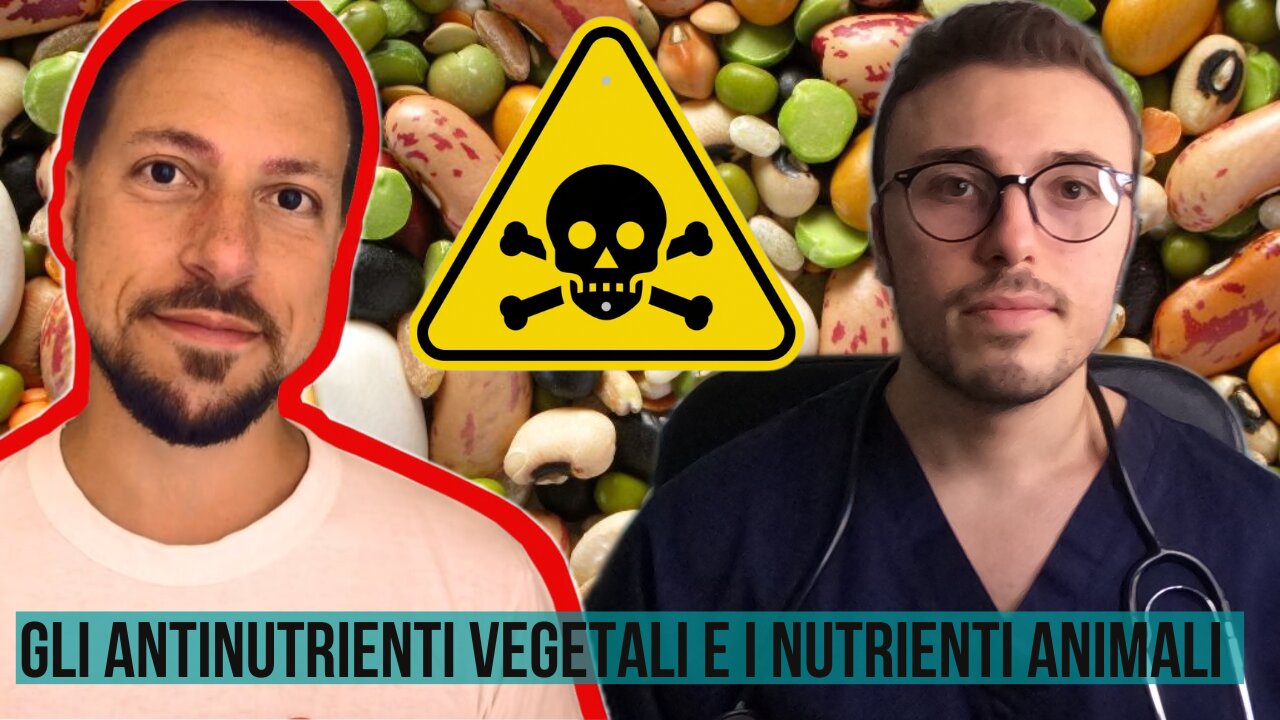Premium Only Content

GLI ANTINUTRIENTI (VEGETALI) E I NUTRIENTI ANIMALI (CARNE)
Ciao, per favore se entra a far parte del mio canale telegram per evitare la censura imperante:
https://t.me/THEANABOLICDOC
A forte richiesta: un altro episodio della rubrica "4 chiacchiere con Roberto di Diario carnivoro", (Roberto)che abbiamo avuto ospite nella trasmissione di oggi. Il video di oggi è forse uno dei pochi video sugli antinutrienti di cui gli italiani non hanno mai sentito parlare. La maggior parte di medici e nutrizionisti (90%+) parla solo delle criticità (inesistenti) di tutti i prodotti di origine animale. I vegetali sembrano essere la manna dal cielo quando invece non è così, anzi...
Tornerò a parlare sull'argomento ANTINUTRIENTI in maniera più approfondita potandovi prove scientifiche come ho fatto in tutti i miei video e post ed in tutto ciò che dico, che ho detto e che sempre dirò.
Per chi volesse andare a trovare il canale di Roberto Diario carnivoro può farlo a questo link:
https://www.youtube.com/c/DiarioCarnivoro
Se vuoi ascoltare anche la musica di Roberto, la trovi su questo canale: https://www.youtube.com/channel/UCx2MGg7NTWptuSuOFD-v7Lg
BIBLIOGRAFIA:
(1) Gallo, M. A., History and Scope of Toxicology, in: Klaassen, C. D. (Ed.), Casarett and Doul’s Toxicology. The Basic Science of Poisons, sixth edition, McGraw-Hill Medical Publishing Division, New York, pp. 3–10, 2001.
(2) Frank L. Bryan, Ph. D., M.P.H.. Diseases trasmitted by foods (malattie trasmesse da alimenti). Istituto Scotti Bassani Ed., 1985.
(3) Paoletti, Nicosia, Clementi, Fumagalli: Tossicologia degli alimenti. UTET, 1999.
(4) Derache R., Tossicologia e sicurezza degli alimenti, Tecniche nuove, Milano, 1988.
(5) Bonaga G., Componenti non nutritivi degli alimenti. Nuova Compositori, Bologna, 1998.
(6) Lampe K. F.. Toxic fungi. Am. Rev. Pharmacol. Toxicol. 19:85-104, 1979.
(7) Lincoff G. and Mitchel D.H.. Toxic and hallucinogenic mushroom poisoning. A Handbook for phsycians and mushroom hunters. Van Nostrand Reinhold Co., New York, 1977.
(8) Angelini C.. Le intossicazioni da funghi, http://www.funghiitaliani.it, 2005.
(9) European Food Safety Authority, Opinion of the Scientific Panel on Food additives, Flavourings, processing Aids and Materials in Contact with Food (AFC) on a request from the
commission related to hydrocyanic acid. The EFSA Journal, 105, 1–28, 2004.
(10) Holzbecher, M., Moss, M., Ellenberger, H., The cyanide content of Laetrile preparations, apricot, peach and apple seeds. Clin. Toxicol., 22, 341–347, 1984.
(11) Shibamoto, T., Bjeldanes, L. F., Introduction to Food Toxicology, Academic Press, San Diego, CA 1993.
(12) Laetrile. American Cancer Society (2005-01-06). Retrieved on 2007.
(13) National Research Council, Committee on Food Protection. Toxicants occurring naturally in foods, 2nd ed. National Academy of Sciences, Washington D.C., 1973.
(14) Friedman M., McDonald, G. M., Postharvest changes in glycoalkaloid content of potatoes. Adv. Exp. Med. Biol., 459, 121–143, 1999.
(15) WHO, IPCS Environmental health criteria 80, Pyrrolizidine alkaloids. http://www.inchem.org/documents/ehc/ehc/ehc80.htm. 1988.
(16) Edgar, J. A., Smith, L. W., Transfer of pyrrolizidine alkaloids into eggs. Food safety implications, in: Tu, A. T., Gaffield,W. (Eds.), Natural and Selected Synthetic Toxins: Biological Implications, American Chemical Society, Washington DC, pp. 118–128, 2000.
(17) Shekelle, P., Hardy, M., Morton, S. C., Maglione, M., et al., Ephedra and Ephedrine for Weight Loss and Athletic Performance Enhancement: Clinical Efficacy and Side Effects. Evidence Report/Technology Assessment No. 76 (prepared by Southern California Evidence-based Practice Center, RAND, under Contract No. 290-97-0001, Task Order No. 9). AHRQ Publication No. 03-E022. Rockville, MD: Agency for Healthcare Research and Quality. See: http://www.fda.gov/bbs/topics/NEWS/ephedra/summary.html and http://www.fda.gov/bbs/topics/NEWS/ephedra/summary.html. February 2003.
(18) Scientific Committee on Food (SCF), Opinion of the Scientific Committee on Food on Glycyrrhizinic acid and its ammonium salt. European Commission Health & Consumer Protection Directorate-General. Brüssel, pp. 1–41. http://europa.eu.int/comm/food/fs/sc/scf/out186_en.pdf. 2003.
(19) Mensinga, Tj. T., Sips, A. J. A. M., van den Ham, W., Meulenbelt, J., Gezondheidsrisico's veroorzaakt door het eten van drop., Rapport nr. RIVM 236850 003. 1998.
(20) Scientific Committee on Food (SCF). Opinion of the Scientific Committee on Thujone. Brüssel, pp. 1–11, 2002.
(21) Scientific Committee on Food (SCF), Opinion of the Scientific Committee on Food on the safety of the presence of safrole (1-allyl-3,4-methylene dioxybenzene) in flavourings and other food ingredients with flavouring properties. European Commission Health & Consumer Protection Directorate-General. Brüssel, pp. 1–10, 2002.
-
 22:00
22:00
DeVory Darkins
1 day ago $3.61 earnedBREAKING: Trump announces CEASE FIRE as Democrats dealt LEGAL BLOW by SCOTUS Ruling
10.6K45 -
 1:36:18
1:36:18
Gary Cardone
2 days agoI AM
11.9K2 -
 LIVE
LIVE
Lofi Girl
2 years agoSynthwave Radio 🌌 - beats to chill/game to
1,632 watching -
 16:29
16:29
GritsGG
14 hours agoThis is How We Win 90% of Our Warzone Games
51K2 -
 4:50:20
4:50:20
The Pascal Show
18 hours ago $3.80 earnedDIDDY TRIAL LIVE! Feds FINAL WITNESS Testifies! Gov't To Rest Today Diddy Trial Day 28
18.4K -
 2:20:02
2:20:02
Side Scrollers Podcast
18 hours agoSMASH BROS SCANDAL, DISNEY PREDATOR COULD GET JAIL, MINDSEYE GUTTED | Side Scrollers Live
13.5K6 -
 1:21:26
1:21:26
The Michelle Moore Show
19 hours agoGuest, Steve Jarvis 'MAHA Solutions For Your State Rights To End the Chemtrails' The Michelle Moore Show (June 24, 2025)
66.8K14 -
 2:00:02
2:00:02
Inverted World Live
9 hours agoMake Crop Circles Great Again | Ep. 64
243K13 -
 2:45:21
2:45:21
TimcastIRL
10 hours agoIRAN STRIKE FAILED Claims LEAKED Intel Report, Trump Admin DENIES Report | Timcast IRL
256K172 -
 2:50:06
2:50:06
PandaSub2000
2 days agoGollum... again | ULTRA BEST AT GAMES (Original Live Version)
25.6K2